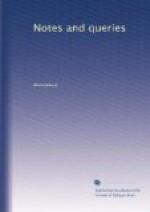“Imprinted for Gwalter Lynne, dwelling upon Somers Kaye, by Byllinges gate. In the yeare of oure Lorde. MDXLVIII. And they by [sic] to be solde at Poules church yarde at the north doore, In the signe of the By-bell, By Richard Jugge.”
This last treatise is in smaller type than the others, and has no general designation: it contains chapters on various subjects, e.g. “The Signification of Baptism,” &c.
Query 1. Is this volume well known? 2. Who were Urbanus Regius and Walter Lynne?
G.P.
March 16. 1850.
* * * * *
REPLIES.
THE ARABIC NUMERALS AND CIPHER.
I might, with a little more consideration, have referred “E.V.” to several other authorities which he will do well to consult.
9. Wallis’s Algebra, p. 9. and p. 153. of the additions.
10. Phil. Trans., Nos. 439. and 475.
11. Montucla, Histoire des Mathematiques, tom. i. chap. 2.
12. Baillie, Histoire de l’Astronomie.
13. Delambre[1], Hist. de l’Astr. du moyen age.
14. Hutton’s Tracts (8vo. ed. 1812.), vol. ii. (subject “History of Algebra”)
15. Huet, Demonstratio Evangelica.
16. Dr. John Taylor’s Translation of the Lilawati. (Bombay, 1816.)
17. Strachey’s Translation of the Bija Ganita[2].
18. Colebrooke’s Algebra of the Hindus.
Would it not be worth while to give a facsimile of the “Tabel for all manere of merchauntes,” in the “Notes and Queries”? It is not only a curiosity, but an important element (and unique as far as is known) in the philosophic history of our arithmetic. It was, no doubt, an actual instrument in constant use in the merchant’s office, as much so as an almanac, interest-tables, a “cambist” and a copying-press, are now.
As regards the cipher, the difficulty only commenced with writing numbers in the new symbology. With persons accustomed to the use of this instrument, there is no doubt that the mode of obviating the difficulty of “keeping the place,” would suggest itself at once. In this instrument an empty hole (without its peg) signified “none of this denomination.” What then more simple than to make the outline of the empty hole which occupied the “local position” of any denomination, when none of that precise denomination occurred in the number itself? Under this view the process at least becomes simple and natural; and as the early merchants contributed so largely to the improvement of our arithmetical processes, such a conclusion is wholly divested of improbability on any other ground. The circle would then naturally become, as it certainly has practically become, the most appropriate symbol of nothingness.




